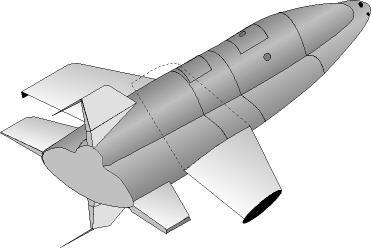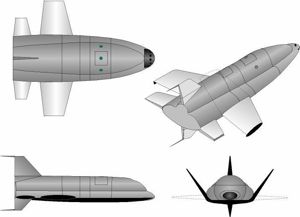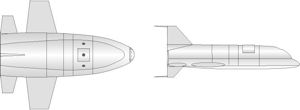
Home - Search - Browse - Alphabetic Index: 0- 1- 2- 3- 4- 5- 6- 7- 8- 9
A- B- C- D- E- F- G- H- I- J- K- L- M- N- O- P- Q- R- S- T- U- V- W- X- Y- Z
PKA

PKA Isometric
PKA Isometric drawing
Credit: © Mark Wade
AKA: Piloted Gliding Spacecraft. Status: Study 1959. Gross mass: 4,500 kg (9,900 lb). Height: 10.00 m (32.00 ft). Span: 8.00 m (26.20 ft).
P V Tsybin's OKB-256 had built the rocket-propelled transonic research aircraft LL-1, LL-2, and LL-3 from 1945. On 23 May 1955 they were selected to build the RS ramjet-powered Mach 3 intercontinental reconnaissance/strike aircraft (air-launched from a Tu-95N bomber), in competition with the V M Myasishchev (OKB-23) RSS-52 system. After the 1957 success of Korolev's R-7 ICBM and cancellation of most Soviet ramjet projects, the RS was redesigned as the RSR reconnaissance aircraft, conventionally flown from runways with turbojets.
In 1957, in response to the USAF Dynasoar project, the same two aviation bureaus were tasked with producing draft project designs for a manned spaceplane.
Tsybin's design was called the gliding spacecraft (PKA). The draft project, undertaken in co-operation with Korolev's OKB-1, was signed by Tsybin on 17 May 1959.
According to the project, the piloted PKA would be inserted into a 300 km altitude orbit by a Vostok launch vehicle. After 24 to 27 hours of flight the spacecraft would brake from orbit, gliding through the dense layers of the earth's atmosphere. At the beginning of the descent, in the zone of most intense heating, the spacecraft would take advantage of a hull of original shape (called 'Lapotok' by Korolev after the Russian wooden shoes that it resembled). After braking to 500 to 600 m/s at an altitude of 20 km, the PKA would glide to a runway landing on deployable wings, which would move to a horizontal position from a stowed vertical position over the back of the spacecraft. Control of the PKA in flight was by rocket jets or aerodynamic surfaces, depending on the phase of flight.
Total time of descent of the PKA from earth orbit would be 90 minutes. Landing would take place on a specially-prepared high-load bearing runway, on bicycle skid gear, rear gear first. The fuselage of the PKA used steel extensively, and was protected from the heat of re-entry by a ventral heat shield, set off from the main spaceframe by a gap of 100 mm. The nose of the PKA and the leading edges of the aerodynamic surfaces, built of steel, used a liquid lithium closed-circuit active cooling system. Maximum external temperature would be 1200 degrees Centigrade, while the internal hot structure would reach 400 degrees. The wings would be stowed at a vertical angle of 55 to 60 degrees, in the aerodynamic shadow of the fuselage, during the period of maximum aerodynamic heating.
Inside the fuselage was the cosmonaut's hermetically sealed cabin and landing capsule, made of aluminum alloy and thermally isolated from the spacecraft hot structure. The cosmonaut was in an ejection seat, which had three positions for launch, work, and rest activities. Also within the cabin was the life support system, two lateral windows, and the astro-orientation system. In the landing section, outside of the fuselage, were various systems not required for orbital flight and landing. To maneuver in orbit the PKA used maneuvering engines (DU). The DU had open exhaust chambers, and shared propellant tanks with two primary rocket engines - the braking and correction engines. Above 90 km the spacecraft was controlled by these engines, which used hydrogen peroxide. Below that altitude aerodynamic surfaces were used.
Up to 10 km altitude during the launch phase the cosmonaut would use the ejection seat for escape. Above that altitude the PKA would separate from the launch vehicle, deploy its wings, and glide to a landing at an emergency airfield.
Korolev was supportive of OKB-256 in this work, as were TsAGI and VIAM. After work on the PKA began, TsAGI studies indicated that many problems of materials and heating had to be resolved. These would require tests of a sub-scale model of the spacecraft.
The Tsybin bureau was closed down shortly after the draft project was completed. Tsybin and his staff transferred to the Myasishchev bureau in October 1959 (which had its own on-going VKA-23 winged spacecraft project). The Myasishchev bureau was then in turn closed and the staff transferred to Filial 1 of Chelomei's OKB-52 bureau in 1960. PKA and VKA-23 engineers were absorbed into the Chelomei Raketoplan spaceplane project team under Khrushchev's son. Work on the RSR/R-020 was stopped by Chelomei in April 1961.
Tsybin himself went to work for Korolev. Tsybin's work on the PKA was passed to the Mikoyan bureau and formed the starting point for the design of the Spiral spaceplane. For Korolev he worked on the Vostok, Soyuz, and Soyuz-T manned spacecraft; AMS planetary probes; and Molniya communications satellite. He was finally Deputy Designer of the Buran space shuttle from 1974 until his death in 1992.
Crew Size: 1.
Family: Spaceplane. Country: Russia. Launch Vehicles: R-7. Agency: Tsybin bureau. Bibliography: 192, 81, 83.
 | PKA 3 View drawing Credit: © Mark Wade |
 | PKA Credit: © Mark Wade |
 | PKA Isometric PKA Isometric drawing Credit: © Mark Wade |
 | PKA 3 View PKA 3 View drawing 340 pixels wide Credit: © Mark Wade |
1959 May 17 - .
- PKA Spaceplane Draft Project - .
Nation: Russia.
Related Persons: Korolev,
Tsybin.
Spacecraft Bus: VKA.
Spacecraft: PKA.
Tsybin's design was called the gliding spacecraft (PKA). The draft project, undertaken in co-operation with Korolev's OKB-1, was signed by Tsybin on 17 May 1959.The piloted PKA would be inserted into a 300 km altitude orbit by a Vostok launch vehicle. After 24 to 27 hours of flight the spacecraft would brake from orbit, gliding through the dense layers of the earth's atmosphere. At the beginning of the descent, in the zone of most intense heating, the spacecraft would take advantage of a hull of original shape (called 'Lapotok' by Korolev after the Russian wooden shoes that it resembled). After braking to 500 to 600 m/s at an altitude of 20 km, the PKA would glide to a runway landing on deployable wings, which would move to a horizontal position from a stowed vertical position over the back of the spacecraft. Control of the PKA in flight was by rocket jets or aerodynamic surfaces, depending on the phase of flight.
1959 September - .
- PKA Spaceplane Draft Project Completed - .
Nation: Russia.
Related Persons: Chelomei,
Myasishchev,
Tsybin.
Spacecraft Bus: VKA.
Spacecraft: PKA.
The Tsybin bureau was closed down shortly after the draft project was completed. Tsybin and his staff transferred to the Myasishchev bureau in October 1959 (which had its own on-going VKA-23 winged spacecraft project). The Myasishchev bureau was then in turn closed and the staff transferred to Filial 1 of Chelomei's OKB-52 bureau in 1960. Tsybin's work on the PKA was passed to the Mikoyan bureau and formed the starting point for the design of the Spiral spaceplane.
Back to top of page
Home - Search - Browse - Alphabetic Index: 0- 1- 2- 3- 4- 5- 6- 7- 8- 9
A- B- C- D- E- F- G- H- I- J- K- L- M- N- O- P- Q- R- S- T- U- V- W- X- Y- Z
© 1997-2019 Mark Wade - Contact
© / Conditions for Use